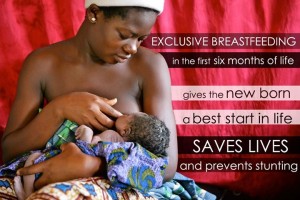According to experts, breastfeeding can prevent the deaths of many babies. VICTOR OKEKE writes that focusing on it alone can reduce infant mortality drastically.
Exclusive breastfeeding for the first 6 months can reduce child deaths by at least 800,000 each year – almost 15% of the total 6.3 million annual child deaths. Babies who are not breastfed are particularly vulnerable to the leading killers of small children and are 15 times more likely to die from pneumonia and 11 times more likely to die from diarrhea, compared to babies who are exclusively breastfed.
According to Leith Greenslade, Vice-Chair at the MDG Health Alliance, “It is not that women don’t understand the value of breastfeeding. Surveys repeatedly show that new mothers across many countries know that breast is best for babies.
However new mothers are concerned that they don’t have enough milk or time; that they experience pain, exhaustion and rejection from their babies; that they feel awkward breastfeeding in public; that spouses are often unsupportive and that it’s just too hard to breastfeed and work. And don’t forget that although world health authorities recommend exclusive breast-feeding for 6 months most countries don’t offer maternity leave beyond three, and typically without pay.”
UNICEF’s landmark 2013 report, Breastfeeding on the Worldwide Agenda, outlines a powerful argument for change describing the current environment as “policy rich” but “implementation poor”.
At the same time, the Bill and Melinda Gates Foundation’s flagship breastfeeding investment – Alive & Thrive – is demonstrating that large increase in breastfeeding are possible with multi-sector action to shift attitudes among new mothers, the behavior of employers and the policies of governments. With this approach, the exclusive breastfeeding rate in the Vietnamese project sites has risen from 19 to 63% and across the Bangladesh sites from 49 to 83% in just three years.
Despite this evidence, rates of early and exclusive breastfeeding are very low in Nigeria and are not improving much. The 2013 Nigerian Demographic & Health Survey reports that although almost all babies (98%) are breastfed in Nigeria, only a minority of mothers (33%) achieves the WHO-recommended initiation within one hour of birth and continues to breastfeed exclusively for six months (17%). Further, an alarming 70% of newborns born at home are fed something other than breast milk during the first three days of life compared to 40% in health facilities.
Today in Nigeria, the babies most likely to be breastfed within an hour of birth are delivered by a doctor, nurse or midwife at a health facility in an urban area (40%), and the babies least likely to start breastfeeding early are delivered without any assistance, at home in rural areas (30%). There is a large range in early initiation rates by States, with the highest rates in Kogi (74%), Kwara (71%), Borno (68%), Abia (64%), Edo (55%) and the Federal Capital Territory-Abuja (51%), and the lowest rates in Kebbi (8%), Zamfara (12%), Taraba (14%), Ebonyi (17%), Katsina (18%) and Lagos (20%).
In general, breastfeeding rates are highest in the North Central and South South Zones and lowest in the North West and South West Zones. Across Nigeria, the mothers most likely to start breastfeeding early and continue for six months exclusively have higher levels of education and incomes. For example, 40 per cent of mothers in rich households breastfeed within an hour of birth, compared to 20 per cent of mothers in poor households, and breastfeed exclusively for almost three times as long.
Meanwhile the countries that have achieved the greatest progress in reducing child mortality and achieving Millennium Development Goal 4 have all recorded exclusive rates of breastfeeding well above the global average including Rwanda (85%), Cambodia (74%), Malawi (70%), Bangladesh (64%), Nepal (70%).
Inspired by these successes and also by what we have learned in the areas of global health that have made the greatest gains though intense, sustained and collective public and private sector action, especially AIDS, malaria and vaccines, it is time for public-private partnerships to drive innovation, progress and deliver results in breastfeeding.
With Nigeria’s sharply rising population driven by a very high fertility rate (an average of 6 children per woman), the under 5 population is forecast to grow by 10 million in the next 15 years. We need to look into PATH’s promotion of human milk banks so that vulnerable newborns have access to human milk in the critical days after birth when their mothers cannot provide it.
Hauwa Abbas of Silver Lining for the Needy Initiative, an NGO focused on improving child and maternal health rates suggests integrating awareness, promotion and support at the community level to existing structures in order to accelerate commitment and coverage of sustainable community level activities on breastfeeding, thus contributing effectively to decreasing child morbidity and mortality.
Also speaking on this, Dr Luther-King Fasehun of the Wellbeing Foundation, an NGO that works through policy advisory, issue-based advocacy, awareness creation, and philanthropy, for improved reproductive, maternal, newborn, child and adolescent health (RMNCAH), suggests that a broad-based, multi-sectoral approach, that is context-specific to coordinate the strengths of all stakeholders in different States and regions of Nigeria, including the private sector, religious institutions, government, and CSOs, is necessary, in order to build a massive positive change in attitudes and policies, supported by the appropriate technologies and market dynamics, that will raise the early and exclusive breastfeeding rates for Nigeria’s children.
–The Leadership Newspaper


Leave a Reply